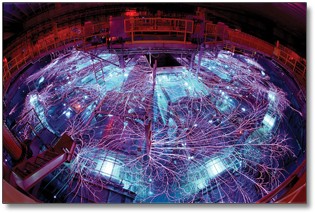Build Me an Engine, Scotty!
By Merry Morris
The University of Alabama's Aerophysics Research Center, NASA, Boeing and Oak Ridge National Laboratory have coined their latest project an "impulse drive" fueled by "dilithium crystals." In doing so they have stoked the imagination of many die-hard Star Trek fans who have been waiting for the advent of a real-life warp drive to go "where no one has gone before..."
Hold Tight to Your Coffee Cup on This Trip!
Actually, this is not the warp drive that Star Trek's Scotty kept in working order that these researchers are collaborating on; it's a Z-pinch fusion engine, which is quite remarkable in its own right. An impulse engine, this machine produces a series of powerful pulses and is capable of creating thrust along the lines of a Saturn V-class rocket. According to the collaborators, "Star Trek fans love it, especially when we call the concept an impulse drive, which is what it is. The fusion fuel we're focusing on is deuterium [a stable isotope of hydrogen] and Li6 [a stable isotope of the metal lithium] in a crystal structure. That's basically dilithium crystals we're using.
Z-pinch Fusion Energy
Z-pinch systems have been an important part of fusion research for many years. In this application, the "impulse" engine produces ongoing pulses to propel the (do we dare say it?) spacecraft forward. The term "Z-pinch" is derived from the physics of the system. The "pinch" is created as high currents from a pulsed power source are quickly released through a large number of human-hair-sized wires. This pulsing power released through the minute wires causes creation of powerful magnetic fields that quickly compress to the point of implosion and create a plasma (a state of matter that is neither solid nor liquid nor gas). As the magnetic field generates the implosion, it "pinches" down on the plasma, releasing tremendous force along the system's Z-axis. Hence, the "Z-pinch" name. In this application, the magnetic fields pinch down on a core of deuterium and lithium, putting into action the fusion of these atoms and unleashing an impressive burst of energy. In this example, the Z-pinch impulse drive might create velocities of 62,600 miles per hour.
Now these velocities don't match the multi-million miles per hour of the Enterprise, and the deuterium and lithium core are not really the same as "dilithium crystals," but they do seem close enough for a good laugh. So as we are chuckling away, may we all "live long and prosper"!

hoto credit: A Z-pinch on the Z Machine at Sandia National Labs.
Classroom Discussion
- Research the difference between fusion energy and fission energy. How are fission reactions generated? How are fusion reactions generated?
- Investigate travel to other planets. How long would a trip to Mars take using todayâs technology?